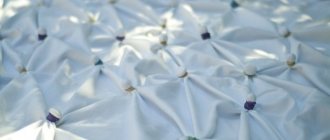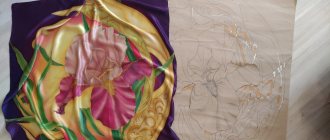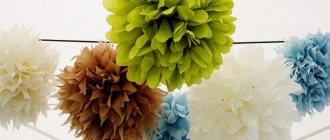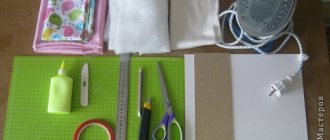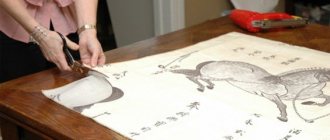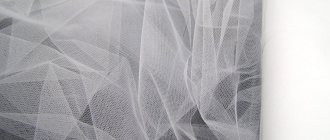If you have long wanted to realize your creative potential, but you don’t know what to do, try a fun activity called batik. Batik is painting on fabric, usually silk is used as the fabric. This type of creativity allows fantasy and imagination to fully manifest itself. Batik began to gain popularity relatively recently, thanks to the growing interest in batik, manufacturers of reserves and paints for every taste have appeared. Let's look at what we need to start the creative process.
Materials and tools
Batik.
Where to begin? 1. We need fabric
, on which we will apply paint. Of the fabrics, it is best to give preference to silk; if it is not possible to buy a real one, then at first an artificial material will do.
2. To paint
, with which we will paint our fabric. To start mastering the art of batik, you can use paints from domestic manufacturers, for example, or German ones. Then you can switch to more expensive and high-quality paints from the German brand “Javana”. You also need to know that paints are divided into acrylic - dense paints that create a hard crust on the fabric - and water-soluble. If you plan to paint flowing silk items, then opt for water-soluble paints.
See also:
- Batik. Practical advice
In addition to choosing paints, you need to know how the paints adhere to the fabric. Some paints are steamed with an iron, by the way, this is the most convenient way, others - with hot steam.
Batik. Where to begin?
3. We need to select a reserve team
. It is selected depending on the technology in which you work. There are hot and cold equipment. The first uses hot wax, the second uses special reserve compounds. Recently, cold wax has begun to appear on store shelves as an alternative to hot wax.
4. To work we will need brushes and pipettes
. As for the choice of brushes, it is better to start working immediately with high-quality gamut brushes. Buy several pipettes, they are needed for working with paints, they help mix paints in small proportions.
5. Buy a sliding frame
. The purpose of the frame is the same as that of a cross-stitch embroidery hoop; they are needed to stretch and fix the fabric for convenience and quality of work.
Batik.
Where to begin? 6. The last attribute for working with batik, which we have not yet mentioned, is the palette.
You don’t have to buy a professional palette; you can use a children’s palette, or adapt improvised means (saucers, lids, vials) for it.
We have considered all the necessary tools and materials for mastering batik painting. Try this amazing type of creativity yourself, and you definitely won’t be able to remain indifferent to it.
See also:
- What is diamond embroidery?
cold and knotty - master class with sketches and drawings
Many people like to decorate their T-shirts and clothes with various designs or inscriptions. Some housewives paint curtains or upholstered furniture in their home, making the interior original. Such designs on fabric are made using the batik method using special paints. If you have not personally encountered such work, you should find out what the batik technique is for beginners.
How to draw on fabric
The art of decorating fabrics came to us from the East. You can learn how to do cold batik for beginners yourself, the master class is quite simple:
1) To learn this technique, you will have to purchase a special kit for working with paint reserves and fabric dyes. You will also need a frame for stretching the fabric.
2) Attach the material to the frame. The fabric can be cotton, silk or crepe de Chine. If you want to create a small display, you can use a hoop.
3) Place a sketch of the future design under the fabric. But do not let the surfaces touch, otherwise the fabric may get dirty. You can use either stenciled or your own sketches. If you have a rich imagination and have artistic skills, draw a picture yourself.
4) Start using the reserve to complete the contours of the drawing. It must be continuous. After this, let the paint dry.
5) Be careful when coloring the drawing so that there are no extra lines. After all, it is almost impossible to remove paint from the surface.
6) After finishing applying the drawing, let it dry. Next, you need to fix the paint on the fabric. This can be done by ironing the designs with an iron.
You can completely dye the fabric a different color. This is usually done by housewives who want to change the curtains. Why buy new ones if the old ones can be repainted.
“Batik” can be used to create dumplings. To make yourself an original T-shirt, you need:
1) Prepare a black T-shirt.
2) Apply the desired design or inscription on it with wax.
3) Dilute bleach in water and dip the T-shirt in it. After a while, pull it out.
4) Remove wax from the fabric and wash the item. Now you can surprise your friends with your original wardrobe.
How to paint with batik
If you want to decorate the walls in your home, you can paint a picture using the batik technique:
1) Secure the fabric to the frame.
2) Use the reserve compound to follow the contour of the desired pattern.
3) Paint the necessary areas, remove the composition.
4) Iron the fabric to set the dyes. You can insert the product into a frame and decorate the wall with it. Paintings in the batik style are quite simple for beginners. Do this with your children, it will be useful for them to get involved in creativity.
There is also an African way of decorating fabrics. It is done using templates. Think about what type of fabric print you need and find an item of that shape. Dip one tip of your template into melted wax and stamp onto the fabric. You can choose the frequency and direction yourself. Paint the product in the desired color, remove the wax. The dress with polka dots or hearts is ready. If you are not an expert in painting clothes, do “batik” for beginners: paintings, small drawings on pieces of fabric.
Nowadays “knotted batik” is very popular. The fabric needs to be twisted well and tied with thread so that it does not fall apart.
Use a brush to paint and saturate your knot with paint. It is better to use different colors to make the drawing more interesting. When the paint is well absorbed into the fabric, let it dry and unroll the product. You will get an unusual and bright color. Smooth out the fabric and you are ready to wear.
Educational video lessons
webdiana.ru
Batik for beginners master class
Batik is a very exciting activity. Anyone can draw using this technique and get excellent results. You don't have to be a professional artist to create. Now you can bring your ideas to life in such an unusual way. No matter how much time drawing takes you, you won’t even notice it.
Tools and materials for batik
In order to create using this technique, you must select the right materials. First of all, attention should be focused on the choice of fabric. Only natural materials are suitable for batik. For example, cotton, silk or linen. The structure of the material must be uniform. You can verify this by doing a small test. Take a small piece of fabric and hold a match to it. Watch how the fabric burns. Synthetic fabric burns very quickly and produces a hard residue. Natural fabrics burn slowly, with a characteristic odor, and after combustion, ash remains.
Beginning artists are recommended to use thin cotton fabric instead of expensive silk. Although silk is ideal for batik. It is recommended to wash cotton fabric in warm water with laundry soap and iron it thoroughly.
You need to buy special paint for batik, but for your first experiments it is better to choose an inexpensive one. To make batik you will also need a reserve compound. You can buy a transparent reserve, and you can add color using acrylic paint. To apply this composition you will need a special glass tube. You need to buy one in medium size.
It is also necessary to use wooden frames or hoops to tension the fabric. The frame should be chosen from soft wood (for example, pine). It will be easier to secure the fabric on such a frame using buttons or needles. To apply paint, you can use both natural and synthetic brushes. The main requirement is that the brushes be soft. However, you can use cotton swabs instead of brushes. You also need a palette for mixing paints. You can use jars instead. In addition, you need a container of water to rinse your brushes and a dry cloth or napkins to dry them. You also need a template for the future drawing. Don't choose overly complex patterns. It's always better to start simple.
Drawing using batik technique
Now that you have everything you need, you can get to work.
- First you need to transfer the design from the template to the fabric. To do this, the material must be attached to the template using pins to make it more convenient to transfer the drawing.
- We transfer the contours of the design onto the fabric using a pencil. Then we stretch the fabric onto the frame or insert it into a hoop. Please note that the material must be stretched like a drum. Only then will you get good quality of your work. Then a reserve substance must be applied to the fabric. Before applying it, it is better to practice on an unnecessary piece of fabric.
- The reserve is applied using a special tube, lightly touching the fabric with it. The reserve must be applied carefully and the line of its application must be closed, otherwise the paint will spread. The line must be drawn smoothly along the contour so that the composition saturates the fabric well.
- After you have applied the reserve compound wherever required, the fabric should be dried until completely dry. This will take approximately forty to fifty minutes. Once dry, you can check that the reserve has been applied accurately. To do this, dilute a couple of drops of shampoo or liquid soap in a small amount of water.
- Then, with a brush, apply this water along the closed contour that you outlined with the composition. If the water goes beyond the contour, the reserve has been applied carelessly. Mark the places of water leakage with a pencil, and after the touch has dried again, apply more reserve there, but from the wrong side. Dry again.
- Once you are confident that the reserve has been applied securely, you can begin painting. The paint can be either diluted or applied undiluted.
- You can use a brush or cotton swabs for application. Light colors should be applied first and then dark colors. The dye solution spreads quite easily over the fabric, so the work will not take as much time as it seems at first glance. If you are painting a large surface with one color, then after applying the paint it is recommended to wipe it with a piece of cotton wool. Once you have applied the entire pattern, leave it to dry in a well-ventilated area.
- After drying, you should decide how exactly you plan to use the batik further. You can frame it and hang it on the wall like a painting. Apart from this, you can use this fabric in the kitchen or wear it. In this case, the design on the fabric should be fixed, and the fabric should be steamed.
Steaming batik
Fabric with a pattern must be wrapped in paper. Newspaper should not be used as wrapping material. The fabric must be wrapped so that its colored parts do not touch each other. You can wrap it arbitrarily, as long as the paper ends up on the outside.
Steam treatment can be carried out using a pan or bucket, at the bottom of which there should be water (the thickness of the water layer should be about five centimeters). You need to stretch a synthetic rope between the two handles of the pan. You need to hang a bundle of batik tied with twine from it. The lid is covered with a terry towel folded in half. The pan needs to be heated. If your work is small and you have folded it three or four times, then half an hour is enough to heat it up. If you have a large design (for example, you designed a scarf), then it will take longer to steam it. After steaming, iron the work.
Batik is not as difficult an art as it seems. But with its help you can realize your ideas in an original and beautiful way.
Especially for LadySpecial.ru – Marie Matveyuk
ladyspecial.ru

